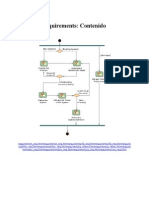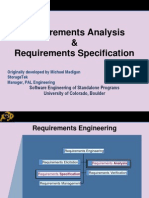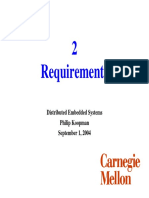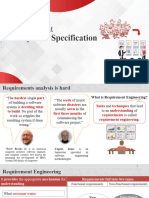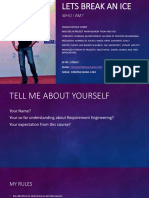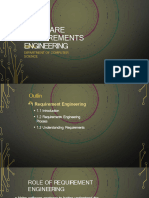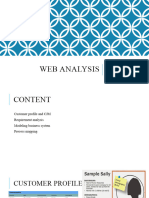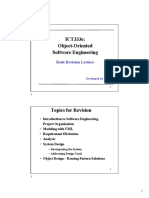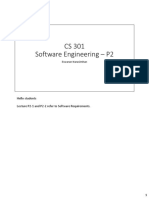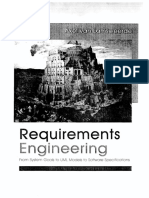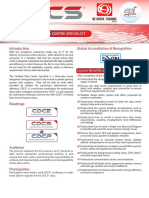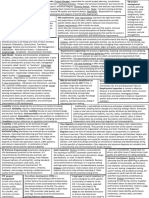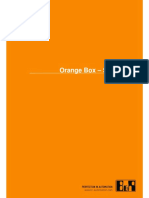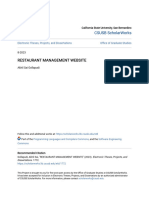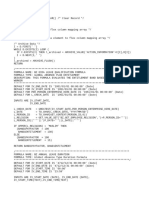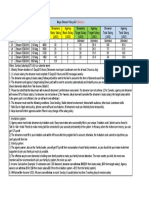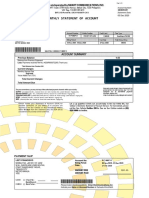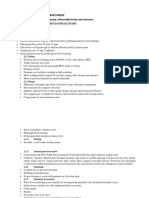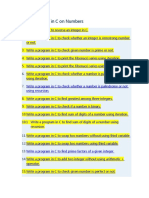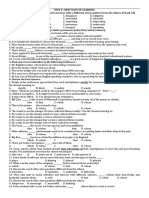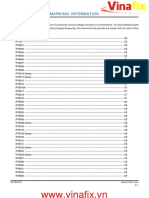FRD Example
Uploaded by
priyankamanoj.mailsFRD Example
Uploaded by
priyankamanoj.mailsCompany Logo Project Name
Table of Contents
1. Introduction ...............................................................................................................................................3
1.1 Purpose of Document ..........................................................................................................................3
1.2 Project Summary ................................................................................................................................. 3
1.3 Background ..........................................................................................................................................3
1.4 Project Scope .......................................................................................................................................4
1.5 System Purpose ................................................................................................................................... 5
1.5.1 Users .............................................................................................................................................5
1.5.2 Location ........................................................................................................................................ 5
1.5.3 Responsibilities .............................................................................................................................5
1.5.4 Need ............................................................................................................................................. 6
1.6 Overview of Document ....................................................................................................................... 6
2. Functional Objectives ................................................................................................................................ 7
2.1 High Priority .........................................................................................................................................7
2.2 Medium Priority .................................................................................................................................. 7
2.3 Low Priority ..........................................................................................................................................7
3. Non-Functional Objectives ........................................................................................................................ 8
3.1 Reliability ............................................................................................................................................. 8
3.2 Usability ............................................................................................................................................... 8
3.3 Performance ........................................................................................................................................ 8
3.4 Security ................................................................................................................................................ 8
3.5 Supportability ...................................................................................................................................... 8
3.6 Online user Documentation and Help .................................................................................................8
3.7 Purchased Components ...................................................................................................................... 8
3.8 Interfaces .............................................................................................................................................9
4. System Externals .........................................................................................Error! Bookmark not defined.
Customer ............................................................................................................................................... 9
Sales Agent ............................................................................................................................................ 9
Product Owner ...................................................................................................................................... 9
Accounting .............................................................................................................................................9
Shipping ................................................................................................................................................. 9
Marketing .............................................................................................................................................. 9
Functional Requirement Documents - V1.0
Company Logo Project Name
5. The Use Case Model .................................................................................................................................. 9
5.1 System Use Case Diagram ................................................................................................................... 9
5.2 Use Case Descriptions (for selected cases) ......................................................................................... 9
Login User ............................................................................................................................................10
Register User ....................................................................................................................................... 10
Register Preferences ........................................................................................................................... 11
Place Order (Customer) .......................................................................................................................12
Place Order (Sales Agent) ....................................................................................................................13
Charge Customer .................................................................................................................................14
Bill Customer ....................................................................................................................................... 14
Request Assistance ..............................................................................................................................15
6. Appendix ..................................................................................................................................................16
Glossary ................................................................................................................................................... 16
Whitepaper ..............................................................................................................................................16
Functional Requirement Documents - V1.0
Company Logo Project Name
1. Introduction
1.1 Purpose of Document
This is a Requirements Specification document for a new web-based sales system for Solar Based Energy,
Inc. (SBE). SBE is a distributor of alternative energy products including windmills, photovoltaics and fuel
cells. The new system will upgrade the current websites to provide customers and employees
customized browsing of the product catalog and the ability to complete product orders on-line. This
document describes the scope, objectives and goal of the new system. In addition to describing non-
functional requirements, this document models the functional requirements with use cases, interaction
diagrams, and class models. This document is intended to direct the design and implementation of the
target system in an object oriented language.
1.2 Project Summary
Project Name: SBE Sales System
Project Manager: Mary Beth Lohse, CEO, CIS 616 Consulting
Project Analysts: Benjamin B. Bolz, Lead Analyst
Cynthia C. Caldwell, Senior Analyst
David D. Dreese, Analyst
Helen H. Hitchcock, Analyst
Responsible Users: Imogene I. Ives, President of SBE
Benjamin B. Baker, Vice-President of Sales
1.3 Background
SBE sells state-of-the-art alternative energy systems utilizing wind and solar power. SBE customers
include both individuals and businesses interested in incorporating wind or solar energy sources into
either new or existing construction. SBE has identified two trends that they believe will cause explosive
growth in the demand for their products. The first is the continuing energy crisis in the western United
States. The second is the maturation of fuel cell technology which provides a feasible system for storing
excess power generation for later use. SBE sells state-of-the-art alternative energy systems utilizing wind
and solar power. SBE customers include both individuals and businesses interested in incorporating
wind or solar energy sources into either new or existing construction. SBE has identified several trends
that they believe will cause explosive growth in the demand for their products. They include the growing
consumer unease with deregulated energy markets, the potential for disruptions to energy imports, and
the maturation of fuel cell technology which provides a feasible system for storing excess power
generation for later use.
Because of the innovative and technical nature of their products, SBE employs sales agents who can
guide customers through the process of choosing an alternative energy system. Other SBE employees
are identified as a product "owners". The product owner is the expert on a particular product or product
line. As the authoritative source of product information he produces whitepapers--highly technical and
focused documents on product specifications.
Functional Requirement Documents - V1.0
Company Logo Project Name
As alternative energy becomes more mainstream, SBE anticipates changes in the needs of their
customers. Some customers will be more knowledgeable and will need less assistance from a sales
agent. Expanding sales outside the United States will drive the need to service customers in languages
other than English.
Currently there are two separate web sites. The public website (www.sbe.com) is static HTML. It
provides general information about SBE and its products. Customers who are interested in ordering are
provided contact information for the nearest SBE sales office. The internal website (www.sbesales.com)
is restricted to SBE employees and provides detailed product information. Sales orders are placed by
agents on this site. Two different Oracle databases underly these sites.
Problems with the current system include
the information available on the public website is too limited and the user cannot immediately place an
order
the existence of two databases means information is often inconsistent or incorrect
users who need more technical information have difficulty accessing the relevant whitepapers
sales agents have difficulty reaching product owners
Imogene I. Ives, President of SBE has requested that an analysis be done with a view to reengineering
the current sales system. The new system should allow customers direct access to product information
and ordering as well as continuing to provide support to the existing sales agent network.
1.4 Project Scope
The scope of this project is a web-based system that supports the marketing of SBE products directly to
customers as well as through the existing sales agent network. Advertising of products, inventory
control, and account billing are not part of this project.
The two current web sites will be replaced by this new system. In addition, changes to the logical and
physical design of the current databases are expected. The actual implementation of a new database
system is not part of this project. A web search engine and language translator will be obtained as
purchased components for the new system. Their internal details are not part of this project. Issues of
website security, other than password protection within the site, are not part of this project.
Functional Requirement Documents - V1.0
Company Logo Project Name
1.5 System Purpose
1.5.1 Users
Those who will primarily benefit from the new system and those who will be affected by the new system
include
Customers:
Upon implementation of the new system, customers will find site navigation, product identification and
product ordering easier. Customers will be able to choose whether to buy directly from SBE or work with
a sales agent.
Sales Agents:
The new system will provide sales agents with more detailed, accurate and up-to-date product
information. They will be informed of potential customers more quickly and they will have faster access
to the product owner.
Product Owners:
Product owners will be allowed to maintain the data about their products directly. This will eliminate
delays in getting new products or changed product specifications into the system.
Customer Service Department:
The new system should reduce the workload of Customer Service as customers are able to find the
information they need from the web-site.
Marketing Department:
Site navigation data could be sent to the Marketing Department. Understanding how a customer uses
the web site to make a purchase will result in improvements in getting and keeping customers.
Accounting Department:
Purchase information will be sent directly to Accounting, allowing for more accurate and timely billing.
Shipping Department:
Purchase information will be sent directly to Shipping for inventory control and order processing.
Information Technology Department:
This department will be responsible for implementing the new database, hosting the website and
maintaining the system.
1.5.2 Location
The system will be available to any potential customer using the Internet. SBE employees may also use
the system from any location and will be able to access restricted areas of the site through a password
protection scheme.
1.5.3 Responsibilities
The primary responsibilities of the new system:
Functional Requirement Documents - V1.0
Company Logo Project Name
provide customers direct access to up-to-date, accurate product information on which they can
make a decision to buy
customize product offerings to specific users
allow differential access to web pages based on type of user
allow customers to place an order through the website
allow customers to request the assistance of a sales agent
provide sales agents improved access to product information and product owners
allow product owners to maintain information about their products directly
allow access to whitepapers on demand
send order information directly to Accounting and Shipping
Other desired features of the new system:
a consistent "look and feel" throughout the website
full-text searches of the web pages a user has permission to access
on-line help in website navigation
password protection scheme for non-public web pages
translation of a web page to another language
The system will not be responsible for account receivables, or inventory control.
1.5.4 Need
This system is needed in order to service the expected increase in demand for alternative energy
products. Replacement of the current websites will eliminate the shortcomings of those sites. The new
system will allow SBE to rapidly increase sales without a large and expensive increase in the number of
sales agents and other customer support employees.
1.6 Overview of Document
The rest of this document gives the detailed specifications for the new sales system. It is organized as
follows:
Section 2: Functional Objectives
Each objective gives a desired behavior for the system, a business justification, and a measure to
determine if the final system has successfully met the objective. These objectives are organized
by priority. In order for the new system to be considered successful, all high priority objectives
must be met.
Section 3: Non-Functional Objectives
This section is organized by category. Each objective specifies a technical requirement or
constraint on the overall characteristics of the system. Each objective is measurable.
Section 4: Context Model
This section gives a text description of the goal of the system, and a pictorial description of the
scope of the system in a context diagram. Those entities outside the system that interact with
the system are described.
Section 5: Use Case Model
The specific behavioral requirements of the system are detailed in a series of use cases. Each use
case accomplishes a business task and shows the interaction between the system and some
Functional Requirement Documents - V1.0
Company Logo Project Name
outside actor. Each use case is described with both text and an interaction diagram. An interface
prototype is also shown. The system use case diagram depicts the interactions between all use
cases and system actors.
Section 6: An appendix containing a glossary that defines terms specific to this project
2. Functional Objectives
2.1 High Priority
1. The system shall allow for on-line product ordering by either the customer or the sales agent.
For customers, this will eliminate the current delay between their decision to buy and the
placement of the order. This will reduce the time a sales agent spends on an order by x%. The
cost to process an order will be reduced to $y.
2. The system shall reflect a new and changed product description within x minutes of the
database being updated by the product owner. This will reduce the number of incidents of
incorrectly displayed information by x%. This eliminates the current redundant update of
information, saving $y dollars annually.
3. The system shall display information that is customized based on the user's company, job
function, application and locale. This feature will improve service by reducing the mean number
of web pages a user must navigate per session to x. It should reduce unnecessary phone calls to
sales agents and staff by x%.
4. The system shall allow employees to view the owner of any product. An employee should be
able to contact the correct owner in one phone call x% of the time.
5. The system shall allow a customer to directly contact the nearest sales office in his region. This
will improve service by reducing the time to respond to a customer request to no more than x
days.
6. The system shall provide accounting with accurate purchase transaction data. This will improve
customer service by reducing billing complaints by x% and save $y in correcting inaccurate
accounts.
7. The system shall provide shipping with accurate order data. This will allow the order to be
processed in x days and inventory to be updated within y hours.
2.2 Medium Priority
1. The system shall provide a search facility that will allow full-text searching of all web pages that
the user is permitted to access. The system must support the following searches:
a. find all words specified
b. find any word specified
c. find the exact phrase
d. Boolean search
2. The system shall make whitepapers available from the product page. This will allow customers
to answer product questions themselves, reducing customer support costs by $x annually.
2.3 Low Priority
1. The system shall allow the user's status to be stored for the next time he returns to the web site.
This will save the user x minutes per visit by not having to reenter already supplied data.
Functional Requirement Documents - V1.0
Company Logo Project Name
2. The system shall provide marketing with customer navigation information. This information will
allow marketing to determine what information prompts a purchase and help target potential
customers more effectively. This will increase annual revenue by $x in additional sales.
3. The system shall translate web pages into the languages of the countries where the company's
products are available. This will improve customer service and reduce the number of support
calls from foreign customers by x%.
3. Non-Functional Objectives
3.1 Reliability
The system shall be completely operational at least x% of the time.
Down time after a failure shall not exceed x hours.
3.2 Usability
A sales agent should be able to use the system in his job after x days of training.
A user who already knows what product he is interested in should be able to locate and view
that page in x seconds.
The number of web pages navigated to access product information from the top page should
not exceed x.
3.3 Performance
The system should be able to support x simultaneous users.
The mean time to view a web page over a 56Kbps modem connection shall not exceed x seconds.
The mean time to download and view and whitepaper in PDF format for a 56Kbps modem shall
not exceed x seconds.
3.4 Security
The system shall provide password protected access to web pages that are to be viewed only by
employees.
Transaction data must be transmitted in encrypted form.
3.5 Supportability
The system should be able to accommodate new products and product lines without major
reengineering.
The system web site shall be viewable from Internet Explorer 4.0 or later, Netscape
Navigator/Communicator 3.0 or later and the America Online web browser version 3.0 or later.
3.6 Online user Documentation and Help
The system shall provide a web page that explains how to navigate the site. This page should be
customized based on what pages that user is allowed to access.
This help page should be accessible from all other pages.
3.7 Purchased Components
A language translation tool from English to French and English to German will be needed.
A web site search engine will be needed.
Functional Requirement Documents - V1.0
Company Logo Project Name
3.8 Interfaces
The system must interface with
The current Oracle database systems for product and order information
The current Oracle Financial accounting system
The current AccountPro inventory system
The acquired language translation tool
The acquired web site search engine
4. System Externals
Customer
A customer is any user of the system that has not identified himself as an SBE employee. A customer
may search for public product information by keyword, access whitepapers for a particular product,
order a product or request assistance from a sales agent. A customer who provides personal information
will get search and query results customized to his preferences.
Sales Agent
A sales agent is a user who has been verified as an SBE employee. A sales agent may access all available
product information and whitepapers, including the product owner. A sales agent may place an order on
behalf of a customer. He will be informed by the system of any customers in his region who have
requested assistance.
Product Owner
The product owner is a user who has been verified as an SBE employee. The product owner may update
product information and whitepapers for those products for which he is responsible.
Accounting
The Accounting department is responsible for all SBE financial transactions. The Accounting department
is informed of all purchases and is responsible for later collection of accounts receivable.
Shipping
The Shipping department is informed of purchases so that it can process the order and update inventory.
Marketing
The Marketing department is responsible for creating demand for SBE products. It will receive website
navigation data to use in planning marketing strategies.
5. The Use Case Model
5.1 System Use Case Diagram
5.2 Use Case Descriptions (for selected cases)
Notes:
Functional Requirement Documents - V1.0
Company Logo Project Name
For all use cases, the user can cancel the use case at any step that requires
user input. This action ends the use case. Any data collected during that use
case is lost.
For all use cases that require a logged in user, the current login session is
updated during the use case to reflect the navigation paths through the use
case.
Login User
Use Case Name: Login User
Summary: In order to get personalized or restricted information, place orders or do other
specialized transactions a user must login so that that the system can determine his
access level.
Basic Flow: 1. The use case starts when a user indicates that he wants to login.
2. The system requests the username and password.
3. The user enters his username and password.
4. The system verifies the username and password against all registered users.
5. The system starts a login session and displays a welcome message based on
the user's preferences.
Alternative Step 4:
Flows:
if username is invalid, the use case goes back to step 2.
Step 4:
if the password is invalid the system requests that the user re-enter the
password. When the user enters another password the use case continues
with step 4 using the original username and new password.
Extension none
Points:
Preconditions: The user is registered.
Postconditions: The user can now obtain data and perform functions according to his registered access
level.
Business Rules: Some data and functions are restricted to certain types of users or users with a
particular access level.
Register User
Use Case Name: Register User
Functional Requirement Documents - V1.0
Company Logo Project Name
Summary: In order to get personalized or restricted information, place orders or do other
specialized transactions a new user must register a username and password.
Basic Flow: 1. The use case start when a user indicates that he wants to register.
2. The system requests a username and password.
3. The user enters a username and password.
4. The system checks that the username does not duplicate any existing
registered usernames.
5. The system requests a name (*), street, city, state, zipcode(*), phone and
email address. Items marked by (*) are required.
6. The user enters the information.
7. The system determines the user's location and access level and stores all user
information.
8. The system executes use case Register Preferences.
9. The system starts a login session and displays a welcome message based on
the user's preferences.
Alternative Step 4: If the username duplicates an existing username the system displays a
Flows: message and the use case goes back to step 2.
Step 5: If the user does not enter a required field, a message is displayed and
the use case repeats step 4.
Extension Register Preferences
Points:
Preconditions: none
Postconditions: The user can now obtain data and perform functions according to his registered access
level.
Business Rules: A registered user's location is the SBE location nearest his zip code.
Access levels are
o 0: A user can access only data classification 0
o 1: The user can access data classification <= 1
o 2: The user can access data classification <= 2
The default access level is 0.
Register Preferences
Use Case Name: Register Preferences
Summary: This use case allows a registered user to enter or change his preferences.
Basic Flow: 1. The use case start when a user indicates that he wants to enter or modify his
preferences.
2. The system displays all current product lines. It indicates any product lines
Functional Requirement Documents - V1.0
Company Logo Project Name
that the user has currently selected.
3. The user selects/deselects product lines.
4. The system displays current language preferences. It indicates the language
preference currently selected.
5. The user may select a different language preference.
6. The system stores any change to language preference.
Alternative none
Flows:
Extension Points: none
Preconditions: The user is logged in.
Postconditions: The system can customize a welcome message based on the user's revised
preferences.
Business Rules: Language selections allowed are are English (default), French and German.
Place Order (Customer)
Use Case Name: Place Order
Scenario: Customer places his own order.
Summary: This use case allows a registered customer to place an order for a product.
Basic Flow: 1. The use case start when a customer indicates he wants to place an order for
the current product being displayed.
2. The system displays the customer's information: name, street, city, zip, phone,
email.
3. The customer may add or change any of the information.
4. The system stores any changes. If the zipcode has changed, the system
modifies the customer's location.
5. The system requests the quantity to order and the shipping address.
6. The customer enters quantity and shipping address.
7. The system displays the payment options available to this customer.
8. The customer selects a payment option.
9. The system completes the payment by executing use case Charge
Customer or Bill Customer depending on which option was selected.
10. The system stores the order information, decreases the quantity on hand for
the product and sends the order details to Shipping.
11. The system displays a order completion message and sends a receipt to the
user.
Alternative Step 9:
Flows:
If the selected payment method could not be validated, go to step 8 to get
Functional Requirement Documents - V1.0
Company Logo Project Name
another payment option.
Step 10:
If the quantity on hand is not sufficient for this order, a message is sent to the
customer and the use case is canceled.
Extension Charge Customer; Bill Customer
Points:
Preconditions: The customer is logged in and has completed a search for the product to be ordered
Postconditions: The product is sold.
Business Rules: If a customer has been previously authorized for billing by a sales agent, the customer
may billed for the order. Otherwise the customer must pay in full by credit card at the
time of the order.
Place Order (Sales Agent)
Use Case Name: Place Order
Scenario: Sales agent places an order for a customer.
Summary: This use case allows a sales agent to place an order for a registered customer. It also
allows the sales agent to change the customers access level and payment options.
Basic Flow: 1. The use case starts when a sales agent indicates he wants to place an order for
a customer.
2. The system requests the customers username.
3. The sales agent enters the username.
4. The system displays the registered customer's information, including access
level and payment options.
5. The sales agent makes changes to the customer information.
6. The system stores any updated information.
7. The system requests the product id, quantity and shipping address.
8. The sales agent enters the product id, quantity and shipping address.
9. The system displays payment options for this customer.
10. The sales agent selects a payment option.
11. The system completes the payment by executing use case Charge
Customer or Bill Customer
12. The system stores the order information, decreases the quantity on hand for
the product, sends the order details to Shipping.
13. The system displays a order completion message and sends a receipt to the
customer.
Alternative Step 11:
Flows:
If the selected payment method could not be validated, go to step 10 to get
Functional Requirement Documents - V1.0
Company Logo Project Name
another payment option.
Step 12:
If the quantity on hand is not sufficient for this order, a message is sent to the
sales agent and the use case is canceled.
Extension Charge Customer; Bill Customer
Points:
Preconditions: The sales agent is logged in, knows the username of the customer, his payment
method and the product to be ordered.
Postconditions: The product is sold and the sales agent is credited with the sale.
Business Rules: Sales agent have the authority to allow a customer to be billed. They may also increase
the customer's access level to product data.
Charge Customer
Use Case Name: Charge Customer
Summary: This use case charges the order currently being placed to a credit card.
Basic Flow: 1. The use case begins when a user selects "Credit Card" as a payment option,
while in use case Place Order
2. The system requests the credit card number, type and expiration date.
3. The user enters the information.
4. The system verifies that the credit card is valid for the amount to be charged
and completes the credit card transaction.
5. The system stores the payment details and returns a success message
Alternative Step 4: If the credit card cannot be validated the use case ends, returning a failure
Flows: message
Extension none
Points:
Preconditions: The system is executing use case Place Order.
Postconditions: The customer has been charged for the order.
Business Rules: Credit cards accepted are Visa, MasterCard and Discover.
Bill Customer
Use Case Name: Bill Customer
Functional Requirement Documents - V1.0
Company Logo Project Name
Summary: This system gets the billing details for the order. They will be part of the Daily
Transactions Report sent to Accounting in use case Report Daily Transactions. Billing
and collection is handled outside this system by Accounting.
Basic Flow: 1. The use case begins when a user selects "Bill me" as a payment option, while in
use case Place Order
2. The system requests the billing address.
3. The user enters the billing address.
4. The system stores the payment details.
Alternative none
Flows:
Extension none
Points:
Preconditions: The system is executing use case Place Order and the customer is authorized for billing.
Postconditions: Accounting can bill the customer for this order.
Business Rules: Customers can be billed if it was previously authorized by a sales agent.
Request Assistance
Use Case Request assistance
Name:
Summary: This use case allows anyone using the web site to request a contact from a sales agent.
Basic Flow: 1. The use case starts when the customer asks for assistance.
2. The system displays all product lines, and provides space for the customer to
type a (optional) question.
3. The customer selects the product line(s) he is interested in and may enter a
question.
4. The system asks for a name, email address and zip code.
5. The customer enters name, email address and zip code.
6. The system selects a sales agent based on the customer's location and product
lines selected in step 3.
7. The system displays message informing the customer of which agent will be in
contact.
8. The system sends the request information to the selected sales agent. It stores
the request information for registered customers.
Alternative Step 4:
Flows:
If the customer is registered and has previously provided his name, email
address and zip code the use case skips to Step 6.
Functional Requirement Documents - V1.0
Company Logo Project Name
Step 6:
If the customer is registered and has previously been assisted by a sales agent,
that same agent is selected.
Extension none
Points:
Preconditions: none
Postconditions: The sales agent has the customer contact information.
Business Rules: Customers are assigned to a sales agent at the closest SBE location whose specialties
most closely match the the product lines the customer has indicated. If there is more
than one such sales agent, the one with the fewest customer assistance requests is
selected. That sales agent continues to be assigned to that customer for any future
requests. The actual contact between the sales agent and the customer is outside the
system.
6. Appendix
Glossary
Whitepaper
Technical paper containing detailed product specifications.
Functional Requirement Documents - V1.0
You might also like
- Project Name: Project Manager: Mary Beth Lohse, CEO, CIS 616 Consulting Project Analysts: Benjamin B. Bolz, Lead AnalystNo ratings yetProject Name: Project Manager: Mary Beth Lohse, CEO, CIS 616 Consulting Project Analysts: Benjamin B. Bolz, Lead Analyst16 pages
- Requirements Analysis & Requirements SpecificationNo ratings yetRequirements Analysis & Requirements Specification28 pages
- Requirements Analysis & Requirements Specification100% (2)Requirements Analysis & Requirements Specification28 pages
- Requirements Analysis & Requirements SpecificationNo ratings yetRequirements Analysis & Requirements Specification28 pages
- Lecture#2 - Requirement - Engineering For CSC131No ratings yetLecture#2 - Requirement - Engineering For CSC13152 pages
- Functional Specification Document TemplateNo ratings yetFunctional Specification Document Template11 pages
- Functional & Non-Functional RequirementsNo ratings yetFunctional & Non-Functional Requirements32 pages
- P2 Bruce Douglass-Agile Systems Engineering-45min 250304 135743No ratings yetP2 Bruce Douglass-Agile Systems Engineering-45min 250304 13574322 pages
- 7 - P1 - Requirement Engineering - 24112022No ratings yet7 - P1 - Requirement Engineering - 2411202244 pages
- Functional Specification Document TemplateNo ratings yetFunctional Specification Document Template11 pages
- SE-Unit-4-Requirement Analysis - SpecificationNo ratings yetSE-Unit-4-Requirement Analysis - Specification21 pages
- Requirements Traceability Matrix (RTM) For Systems Engineers PDFNo ratings yetRequirements Traceability Matrix (RTM) For Systems Engineers PDF10 pages
- SkyTrak - Golf Course - Functional Specification Document TemplateNo ratings yetSkyTrak - Golf Course - Functional Specification Document Template11 pages
- Software Requirements Engineering GuideNo ratings yetSoftware Requirements Engineering Guide45 pages
- Business Analysis in Practice - Apex Global - DemoNo ratings yetBusiness Analysis in Practice - Apex Global - Demo61 pages
- IU SE Lecture 7 Requirements EngineeringNo ratings yetIU SE Lecture 7 Requirements Engineering98 pages
- SRE-Lecture-5 (Software Requirements Specification)No ratings yetSRE-Lecture-5 (Software Requirements Specification)23 pages
- Software Requirements Specification GuideNo ratings yetSoftware Requirements Specification Guide30 pages
- Solution Design Document (SDD) : Project Name: Project Code: Author: Position: Phone: Email: (Your Email Address)100% (2)Solution Design Document (SDD) : Project Name: Project Code: Author: Position: Phone: Email: (Your Email Address)33 pages
- CS 301 Software Engineering - P2 - Lecture 1 To 2 PDFNo ratings yetCS 301 Software Engineering - P2 - Lecture 1 To 2 PDF51 pages
- Requeriments Engineer - 1B Intro To ReqsNo ratings yetRequeriments Engineer - 1B Intro To Reqs38 pages
- Reading Four Types of Requirements SummarisedNo ratings yetReading Four Types of Requirements Summarised4 pages
- AccountStatement Report 6068523653 29052024 12 28No ratings yetAccountStatement Report 6068523653 29052024 12 282 pages
- CTA WEB D CAF 005 01 D3.2 Drive by Data Technology Evaluation ReportNo ratings yetCTA WEB D CAF 005 01 D3.2 Drive by Data Technology Evaluation Report91 pages
- UCCNC Software Installation and User's GuideNo ratings yetUCCNC Software Installation and User's Guide82 pages
- Sun Cellular E-Bill-0171889715-2020-12-27No ratings yetSun Cellular E-Bill-0171889715-2020-12-276 pages
- Process Control Narratives: NEORSD Design Standard100% (1)Process Control Narratives: NEORSD Design Standard1 page
- Product Data Sheet: Motion Servo Drive - Lexium 23 - Single Phase 200... 255 V - 1.5 KW - I/ONo ratings yetProduct Data Sheet: Motion Servo Drive - Lexium 23 - Single Phase 200... 255 V - 1.5 KW - I/O9 pages
- RIMS ISACA Bridging The Digital Risk Gap - Res - Eng - 0919No ratings yetRIMS ISACA Bridging The Digital Risk Gap - Res - Eng - 091918 pages
- Supply and Installation of Surface Pump, Submersible Pump and Generator 1.1 Electric Driven Surface PumpsNo ratings yetSupply and Installation of Surface Pump, Submersible Pump and Generator 1.1 Electric Driven Surface Pumps31 pages
- Thunderbolt Technology: Mukesh Kumar SoniNo ratings yetThunderbolt Technology: Mukesh Kumar Soni16 pages
- Introduction To Embedded Systems by Shibu K V100% (3)Introduction To Embedded Systems by Shibu K V748 pages





